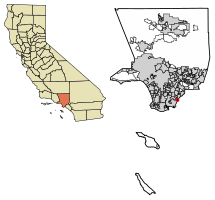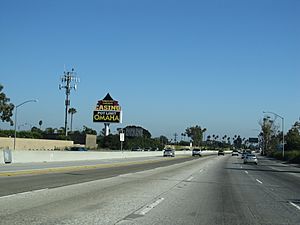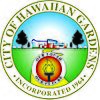Hawaiian Gardens, California facts for kids
Quick facts for kids
Hawaiian Gardens, California
|
|||
|---|---|---|---|

Hawaiian Gardens Civic Center
|
|||
|
|||
| Motto(s):
"Our Youth, Our Future"
|
|||

Location of Hawaiian Gardens in Los Angeles County, California.
|
|||
| Country | |||
| State | |||
| County | Los Angeles | ||
| Incorporated (city) | April 9, 1964 | ||
| Government | |||
| • Type | City Council-Administrator | ||
| Area | |||
| • Total | 0.96 sq mi (2.48 km2) | ||
| • Land | 0.95 sq mi (2.45 km2) | ||
| • Water | 0.01 sq mi (0.03 km2) 1.09% | ||
| Elevation | 33 ft (10 m) | ||
| Population
(2020)
|
|||
| • Total | 14,149 | ||
| • Estimate
(2022)
|
13,593 | ||
| • Density | 14,935.65/sq mi (5,768.48/km2) | ||
| Time zone | UTC−8 (PST) | ||
| • Summer (DST) | UTC−7 (PDT) | ||
| ZIP code |
90716
|
||
| Area code(s) | 562 | ||
| FIPS code | 06-32506 | ||
| GNIS feature ID | 2410716 | ||
Hawaiian Gardens is a city in Los Angeles County, California, United States. It is the smallest city in Los Angeles County by size. The city became official on April 9, 1964. In 2020, about 14,149 people lived there.
The city has a unique name. It comes from a refreshment stand built in the 1920s. This stand was decorated with palm fronds and bamboo, making it look like a Hawaiian spot. It was a famous landmark in the area for many years. As the small town grew, its name stuck. Hawaiian Gardens is one of seven cities in Los Angeles County where casino gambling is allowed. A large part of the city's money, over 65%, comes from the Gardens Casino.
Contents
Where is Hawaiian Gardens?
Hawaiian Gardens is located in Los Angeles County. It shares borders with the cities of Long Beach and Lakewood. It also borders Cypress, which is in Orange County.
The city is quite small. It covers about 1.0 square mile (2.6 km2) of land. Only a tiny part, about 0.01 square miles (0.026 km2), is water. This makes Hawaiian Gardens the smallest city in Los Angeles County by area.
A Look at History
After a time when property prices dropped, Los Angeles started to grow again. By the early 1900s, it had many people. However, the area that is now Hawaiian Gardens was mostly farmland. There were dairy farms, truck farms, and some oil drilling.
In 1927, a fruit stand opened at the corner of Carson Street and Norwalk Boulevard. It was decorated with palms and called "Hawaiian Gardens." This is how the city got its name! During the Great Depression, many people moved to this area. Land was cheap, so they could afford to buy or build homes. Even though the roads were bad and there was often flooding, it was a place where people could start over.
For about 35 years, most roads in the town were dirt. Only a few main roads like Norwalk Boulevard were paved. When Hawaiian Gardens officially became a city in 1964, they started paving roads right away. By 1968, all streets were paved. The main roads were also made wider to handle more traffic.
Important Buildings That Are Gone
Over the years, some well-known buildings in Hawaiian Gardens have been replaced. Here are a few:
- Van Kampen Dairy Drive-In (1959–2011): This popular spot was taken down in 2013 to make a parking lot.
- Bloomfield Elementary School (1924–1986): This school was sold and replaced by a shopping center.
- Homebase Warehouse Store (1989–2007): This store was removed to build the current bingo club.
- Plowboys Market (1956–1999): This family-owned supermarket was replaced by the Gardens Casino.
- Original City Hall and Library (1964–1988): The first city hall and library buildings were taken down in 1988 for a shopping center.
Population Information
| Historical population | |||
|---|---|---|---|
| Census | Pop. | %± | |
| 1930 | 88 | — | |
| 1940 | 432 | 390.9% | |
| 1950 | 1,200 | 177.8% | |
| 1960 | 2,100 | 75.0% | |
| 1970 | 9,052 | 331.0% | |
| 1980 | 10,548 | 16.5% | |
| 1990 | 13,639 | 29.3% | |
| 2000 | 14,779 | 8.4% | |
| 2010 | 14,254 | −3.6% | |
| 2020 | 14,149 | −0.7% | |
| 2022 (est.) | 13,593 | −4.6% | |
| U.S. Decennial Census | |||
Population in 2010
In 2010, Hawaiian Gardens had 14,254 people. Most of the people (77.2%) were of Hispanic or Latino background. About 45.4% were White, 10.6% Asian, and 3.8% African American.
Almost everyone (99.9%) lived in homes with families or roommates. There were 3,562 households. Many households (54.2%) had children under 18 living there. The average household had 4 people. The average age of people in the city was 28.4 years old.
Population in 2000
In 2000, there were 14,779 people in Hawaiian Gardens. The city had 3,507 households. About 62.8% of the people were Hispanic or Latino.
Many households (52.4%) had children under 18. The average household size was 4.21 people. The average age was 25 years.
Schools in Hawaiian Gardens
Hawaiian Gardens is part of the ABC Unified School District.
The city has several schools for younger students:
- Venn W. Furgeson Elementary School
- Hawaiian Elementary School
- Fedde Middle School (which used to be called Killingsworth Junior High School)
Older students who go to high school usually attend Artesia High School in Lakewood.
The city is also connected to the Cerritos Community College District. This means it helps fund facilities for that college. However, Hawaiian Gardens is geographically closer to Long Beach City College.
City's Economy

The city's economy relies on several businesses and organizations. The biggest employer is the Hawaiian Gardens Casino.
Main Employers
Here are the top employers in Hawaiian Gardens, based on a 2020 report:
| # | Employer | # of Employees |
|---|---|---|
| 1 | Hawaiian Gardens Casino | 600 |
| 2 | ABC Unified School District | 100 |
| 3 | City of Hawaiian Gardens | 69 |
| 4 | Food 4 Less | 67 |
| 5 | McDonald's | 50 |
| 6 | 99 Cents Only Stores | 25 |
| 7 | Jack in the Box | 24 |
| 8 (tie) | CVS Pharmacy | 18 |
| 8 (tie) | Howard Contracting Inc. | 18 |
| 10 | Consolidated Color Corp | 15 |
See also
 In Spanish: Hawaiian Gardens para niños
In Spanish: Hawaiian Gardens para niños




